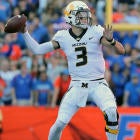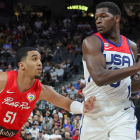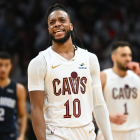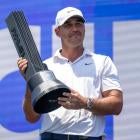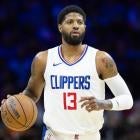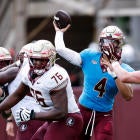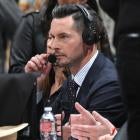Baker Mayfield, Sam Darnold, Josh Rosen, Josh Allen, and Lamar Jackson were always going to be a tough act to follow. So while the 2019 quarterback draft class doesn't stack up with the 2018 group, the collection of passers in the upcoming draft is compelling and bound to feature some highly polarizing prospects.
We have a few experienced and productive signal-callers with easy-to-spot weaknesses, a one-year starter who shattered conference records, and a sub 6-foot-0 Heisman winner with advanced pocket-passing ability and serious scrambling skills.
Here's the ultimate primer on the 2019 quarterback draft class.
The First-Round Candidates
While some -- if not all -- of these quarterbacks would land in the second round of most drafts, they represent what college football has provided to the NFL for this April's draft. With it still being the most vital position on the field, the value of the quarterback spot will almost assuredly push these prospects up boards around the league.
Dwayne Haskins, Ohio State
Haskins started for one season at Ohio State, set numerous Big 10 records, rocked a talented Washington secondary -- in the first half -- of a Rose Bowl victory ... and is now a clear-cut first-round prospect in the 2019 class. Crazy, ascension right? From a clean pocket, the 6-foot-3, 218-pound Haskins is well ahead of his time when it comes to moving through his progressions and reading the entire field. He showcased an occasional drift away from pressure ... but, of course, had extremely raw moments against pressure (check the Penn State game), when he simply looked like he didn't know what to do when he noticed an oncoming pass-rusher. Also worth noting with Haskins ... Ohio State's skill-position talent was outstanding in 2018 and played a huge role in his overall production, although his pinpoint ball placement at the short-to-intermediate levels did accentuate his receivers' ability to accumulate yards after the catch. Haskins is an upgraded, more advanced version of Mitchell Trubisky.
Drew Lock, Missouri
Lock threw 963 more passes than Haskins in his career as a Missouri's four-year starter. While he operated a "new age" spread attack, his offensive coordinators (Josh Heupel and Derek Dooley) certainly tapped into his enormous arm often with a variety of vertical elements to the passing game, which thereby dinged Lock's completion percentage. In 2018, the 6-4, 225-pounder completed 62.9% of his throws at eight yards per attempt with 28 touchdowns and eight picks after tossing 44 touchdowns to 13 picks in 2017. Infrequently, his accuracy can go a little haywire, but he can also stretch a defense like no other quarterback in the class, and his once antsy demeanor inside the pocket after his first read was unavailable greatly improved in his senior season, especially down the stretch. There's a lot of Matthew Stafford to his game.
Kyler Murray, Oklahoma
Murray is the ultimate X-factor in the draft ... and that would've been the case regardless of when he entered the NFL. At (probably) under 5-10 and 200 pounds, the reigning Heisman winner is going to be a lightning rod on the Internet, on TV, and at sports bars over the next few months. I have to get this out first ... Murray is not a running quarterback only. Far from. As I detailed last week ... he's actually quite polished as a passer and, despite his lack of size, possesses a legit, NFL arm. In the pocket, Murray can be extraordinarily patient -- a skill some experienced quarterbacks don't posses -- and showed the ability to read through his progressions across the entire field. Both are rarely seen in signal-caller prospects with one year of starting experience. As a runner, scrambler, and sack-avoider, Murray is a souped-up version of Tyrod Taylor.
Daniel Jones, Duke
Jones would've entered the pre-draft season without Murray or Haskins-esque buzz, and it would've been due to a lackluster end to the season in which he had four-straight games with a completion percentage under 60 ... but he went for 423 yards at 73.1% completion in Duke's bowl game win over Temple in December. He's a tall, pocket passer with three full years of starting experience in the ACC ... scouts will love those facts. Jones works the short passing game wonderfully, and threw accurately on in-breaking routes all season in 2018. His pocket presence is a bit of an enigma. At times, he steps up perfectly while keeping his eyes downfield. Other times, typically when needing to move laterally, Jones is chaotic inside the pocket, can drift into pressure, and makes off-balance throws into traffic. Early in the year, he put some outstanding downfield tosses on the highlight reel. At 6-5, he's an above-average athlete who can be used on read-option keeps and designed runs. Jones can read the entire field too and isn't unaware of how to go through his progressions. If his decision-making and pocket management skills can be cleaned up a bit, Jones can represent tremendous value as the third or fourth quarterback off the board.
The Second Tier
These prospects start the pre-draft process -- and will likely end it -- as fringe first-round picks who're ultimately destined to be picked in Round 2 or Round 3. While this tier doesn't always have this characteristic, all three of 2019's iteration consists of very experienced and very productive starters who simply don't have the physical tools to be viewed as first-round prospects.
Ryan Finley, NC State
The stats indicate Finley improved in 2018, as his completion percentage and yards-per-attempt average improved from 2017. And for most of the year, Finley was better than he'd ever been at the collegiate level. But in two of his final three games, he went under 60% completion and simply looked overwhelmed by coverages and pressure up front. Because of his vast experience -- 1,461 attempts -- in college, ability to make anticipation throws and, at times, stellar pocket presence, Finley is the signal-caller most ready to start as a rookie in the 2019 class. How much better should we expect him to get though? His arm isn't brutal, but it's below-average for the NFL level and will likely get him into trouble on out-breaking routes in the NFL. He's a good athlete and typically knows where pre-snap looks dictate he should throw the football. Finley is adept at moving through full-field reads and has quality touch down the field, although he may not be able to stretch defenses consistently because of his physical limitations. I love his accuracy on back-shoulder throws downfield and his willingness to give his receivers a chance to make a play in tight quarters. Finley had long been a first-round pick in my estimation, but his weaknesses were accentuated down the stretch, and he seems like a classic second-round selection.
Will Grier, West Virginia
Grier will be a fascinating case study regarding the state of NFL offenses. Not big by pro quarterback standards with an arm even less impressive than Finley's, Grier operated Dana Holgersen's Air Raid offense marvelously over the past two seasons. Now, the reputation of Air Raid quarterbacks is in the midst of doing a complete 180 in a short period of time thanks to passers like Jared Goff and Baker Mayfield. For teams open to running a variation of that style of offense, Grier could be near the top of the board at the position. Those unwilling to accept that philosophy could have him as low as a Day 3 pick. A significant amount of Grier's production came via the talent of his pass-catchers after the catch, but he did make many nice downfield passes and flashed -- but wasn't consistent -- moving away from pressure in the pocket. At times, he overextended plays and made bad decisions with pass-rushers in his face and was occasionally baffled by complex coverages.
Brett Rypien, Boise State
Another super-experienced passer in this class, Rypien made over 1,600 attempts in his four-year Boise State career. At 6-2 and just over 200 pounds, he's on the small side for the NFL but generates plenty of velocity down the field and on throws across the field to the sideline. A textbook pocket passer, Rypien often misses oncoming defenders because his eyes almost never drop. That led to him finding receivers late in the play but also taking more hits and sacks than he needed to. However, absorbing extra hits with your eyes up is better than dropping your eyes at the first sign of pressure. Accuracy is not a problem with Rypien, and he has a very aggressive style on seam throws and downfield shots. Rypien looks like an early Day 3 pick primed to outplay his draft position.
The Potential Massive Risers
Every year now at least one quarterback prospect starts the pre-draft process well off the first-round radar but skyrockets up boards and into the first round ... sometimes even the top 10, top 5, or even No. 1 overall. Last year, that was Baker Mayfield. Two years ago, Mitchell Trubisky and Patrick Mahomes flew into the No. 2 and No. 10 overall spots respectively. In 2016, Carson Wentz was widely considered a second-or-third-round prospect in January and landed at No. 2 overall in April.
Tyree Jackson, Buffalo
At 6-7 and 245 pounds with a big arm and a long highlight reel of in-the-bucket throws downfield on his collegiate resume, Jackson looks the part of a "massive riser." He's raw as a passer, and his accuracy and decision-making waned as the season progressed. But it's not crazy to assume a team in the middle or back end of the first-round would pick him there and stash him for a season or two to develop.
Clayton Thorson, Northwestern
While not as physically impressive as Jackson, Thorson will check physical boxes at 6-4 and 225 pounds. He started at Northwestern for four seasons with mixed results. His sophomore season in 2016 stands out ... Thorson tossed 22 touchdowns and nine interceptions at the highest yards-per-attempt average (6.7) of his Wildcats career. I can see a team dwelling on that year then, with hopes of getting something similar out of him in the NFL, selecting him with a relatively early pick.
The Super Sleepers
Which quarterbacks could start the pre-draft process as far down boards as a Day 3 or priority free agent and ultimately go on Day 2 ... a la Jimmy Garoppolo in 2014? I've identified two of those types ... one from the small-school level and one who had a dazzling season in the Air Raid system.
Easton Stick, North Dakota State
No, we aren't talking about Wentz 2.0 here, but same, outrageously successful school in the FCS. The Bison have won seven of the past eight titles at that level, and Stick was the starter for the past two (after Wentz). At 6-2, 220, Stick has a live arm but at times long throws to the sideline dipped as they got to their intended target. His pocket patience is better than his pocket drifting, and from a clean pocket, Stick's a highly efficient, accurate passer who shows a good mix of taking what the defense gives underneath along with stretching the defense on vertical routes. He put some Trubisky-ian scrambles on film but needs to get better keeping his eyes downfield as pressure is mounting. His downfield touch is good, not great, but he reads coverages well and can calmly scan the entire field. With a big week at the East-West Shrine game, Stick could begin his climb up boards.
Gardner Minshew, Washington State
Minshew is entering the NFL at the absolute perfect time. Coming from Mike Leach's Air Raid system ... that went from toxic to extremely trendy in the matter of two seasons in the pros. Minshew doesn't have great size -- 6-2, 220 -- or an NFL-caliber arm ... but he ran Washington State's Air Raid outstandingly in 2018 with 38 touchdowns and nine interceptions at nearly 71% completion. Because of his physical limitations and one season of high-caliber production, he'll likely get picked later in the draft, but in the right system, he could emerge as a point guard type signal-caller at the NFL level.












